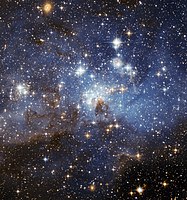
Photo from wikipedia
One of the main problems in planet formation, hampering the growth of small dust to planetesimals, is the so-called radial-drift barrier. Pebbles of cm to dm sizes are thought to… Click to show full abstract
One of the main problems in planet formation, hampering the growth of small dust to planetesimals, is the so-called radial-drift barrier. Pebbles of cm to dm sizes are thought to drift radially across protoplanetary discs faster than they can grow to larger sizes, and thus to be lost to the star. To overcome this barrier, drift has to be slowed down or stopped, or growth needs to be sped up. In this paper, we investigate the role of porosity on both drift and growth. We have developed a model for porosity evolution during grain growth and applied it to numerical simulations of protoplanetary discs. We find that growth is faster for porous grains, enabling them to transition to the Stokes drag regime, decouple from the gas, and survive the radial-drift barrier. Direct formation of small planetesimals from porous dust is possible over large areas of the disc.
Journal Title: Monthly Notices of the Royal Astronomical Society
Year Published: 2020
Link to full text (if available)
Share on Social Media: Sign Up to like & get
recommendations!